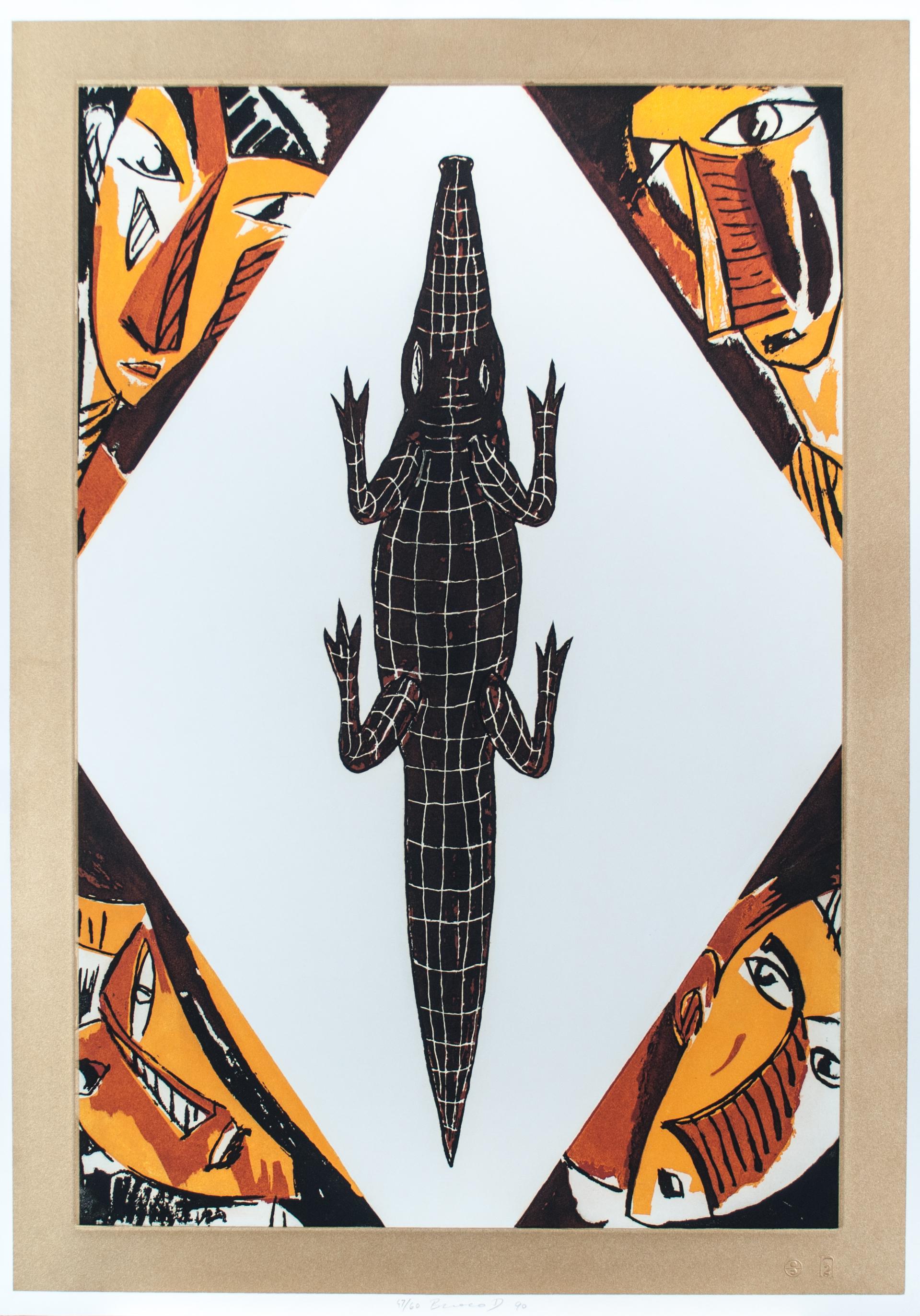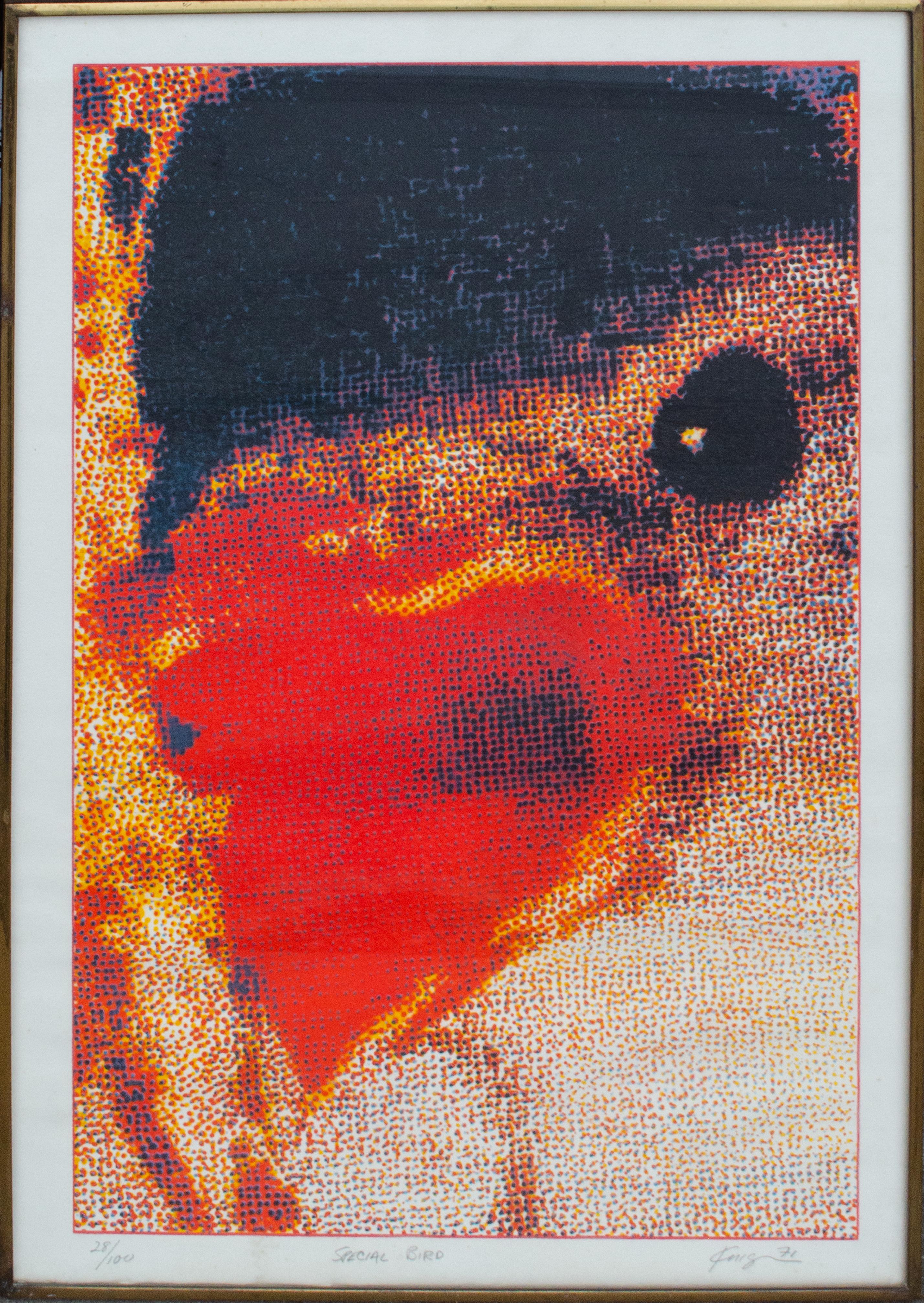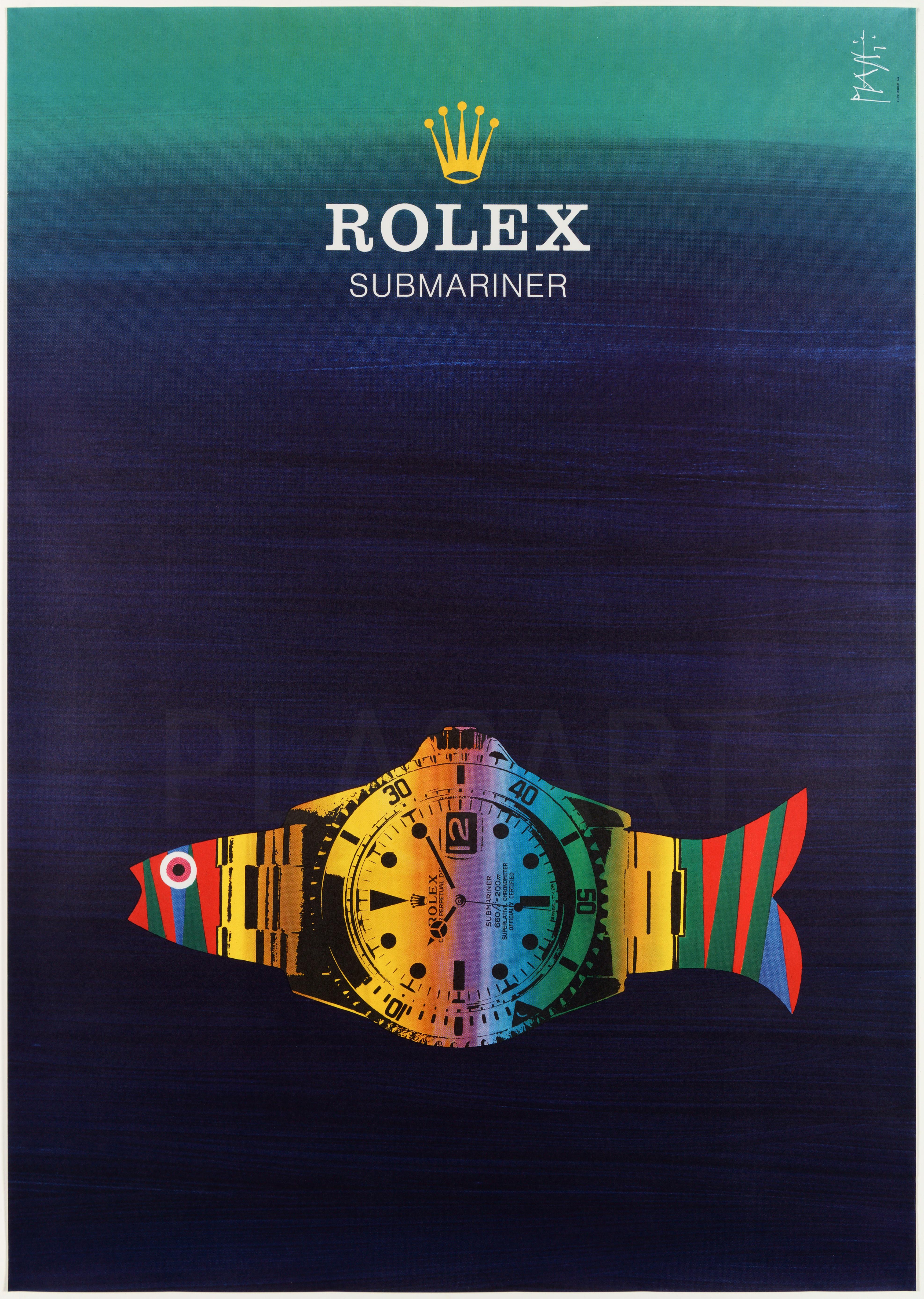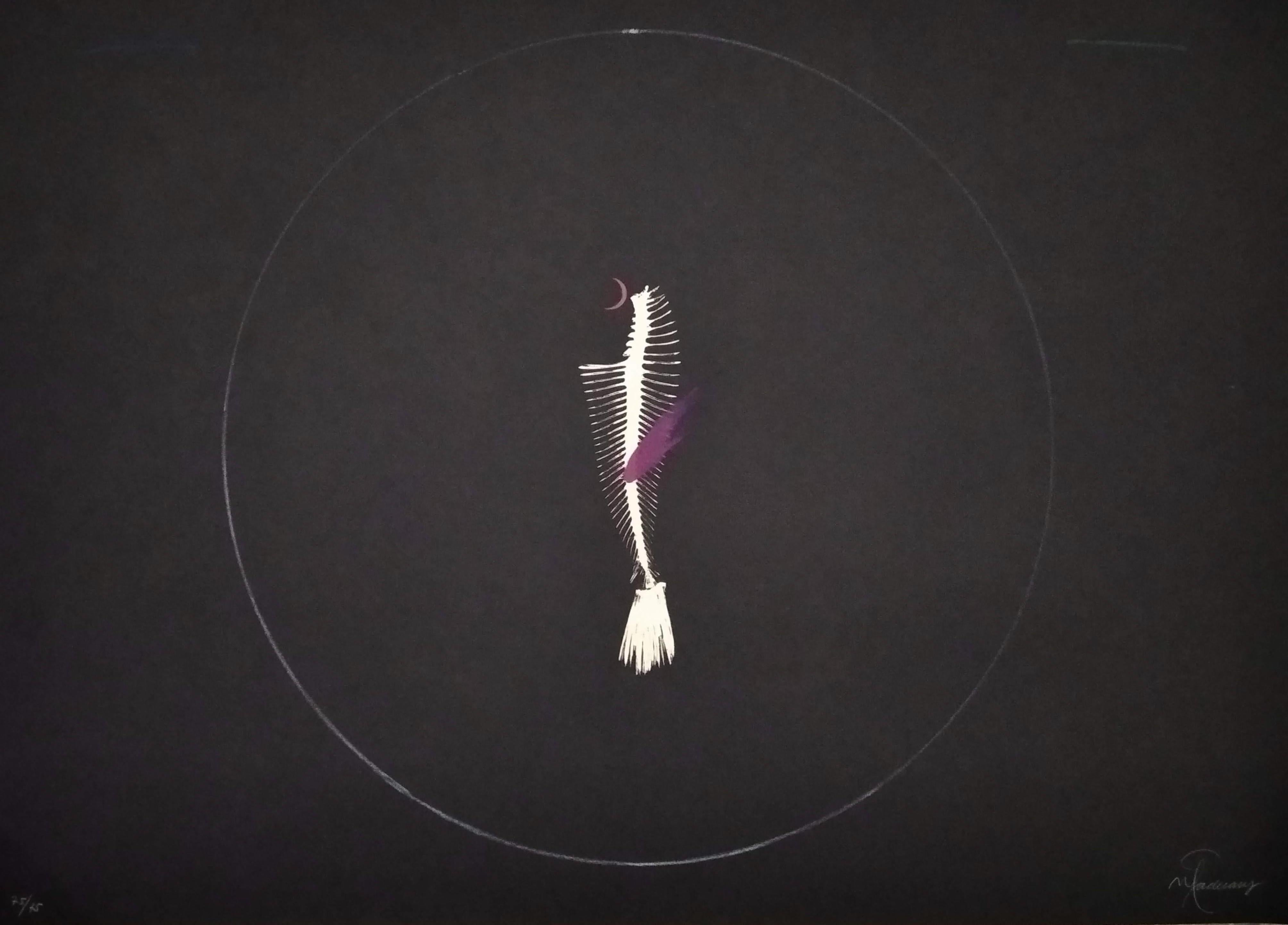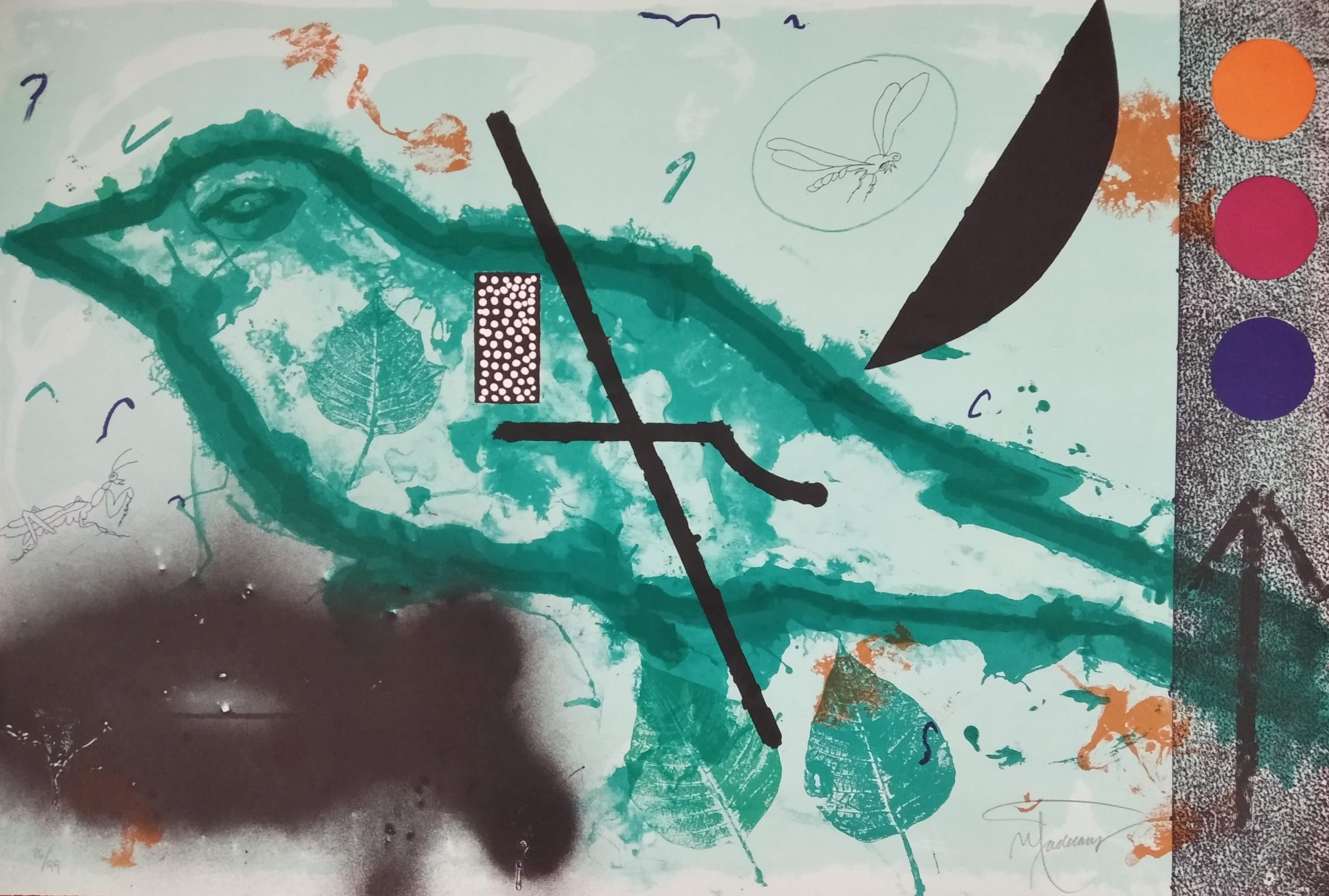Items Similar to Impressionabilita
Want more images or videos?
Request additional images or videos from the seller
1 of 11
Marino MariniImpressionabilita1969
1969
About the Item
This artwork titled "Impressionabilita" 1969, is an original color screen print on wove by noted Italian artist Marino Marini, 1901-1980. It is hand signed and numbered 93/125 in pencil by the artist. The image size is 26 x 26.5 inches, apparent paper size is 27.75 x 27.75 inches, framed size is 35.35 x 35.5 inches. Published by Toninelli Arte Moderna, Milan. Custom framed in a wooden off white frame, with off white matting. It is in excellent condition, the frame have very small minor restorations, practically invisible.
Marino Marini was a graphic artist, painter, and sculptor. Marini started as a painter and studied at the Accademia di Belle Arti in Florence, Italy.
Marini gained inspiration and critiques of his work from some of the top Italian artists working in Paris at the time, including Alberto Magnelli, Giorgio de Chirico, and Massimo Campigli. The Marino Marini Museum in Florence has more than 100 of his works on permanent display. One of his most famous pieces is the sculpture "Cavaliere," which earned more than $7 million at auction in 2010. His work is displayed in major collections and museum around the world.
- Creator:Marino Marini (1901-1980, Italian)
- Creation Year:1969
- Dimensions:Height: 35.35 in (89.79 cm)Width: 35.5 in (90.17 cm)Depth: 1.25 in (3.18 cm)
- Medium:
- Movement & Style:
- Period:
- Condition:
- Gallery Location:San Francisco, CA
- Reference Number:
About the Seller
5.0
Platinum Seller
These expertly vetted sellers are 1stDibs' most experienced sellers and are rated highest by our customers.
Established in 1999
1stDibs seller since 2017
682 sales on 1stDibs
Typical response time: 1 hour
- ShippingRetrieving quote...Ships From: San Francisco, CA
- Return PolicyA return for this item may be initiated within 7 days of delivery.
More From This SellerView All
- Prowling LeopardBy LeRoy NeimanLocated in San Francisco, CAThis artwork titled "Prowling Leopard" 2003 is an original color serigraph by noted American artist LeRoy Neiman, 1921-2012. It is hand signed and numbered 64/425 in pencil by the artist. The image size is 26.5 x 35 inches, framed size is 40 x 48 inches. It is custom framed in a gold frame, with fabric matting and green/gold spacer. It is in excellent condition. About the artist: Mr. Neiman's kinetic, quickly executed paintings and drawings, many of them published in Playboy, offered his fans gaudily colored visual reports on heavyweight boxing matches, Super Bowl games and Olympic contests, as well as social panoramas like the horse races at Deauville, France, and the Cannes Film Festival. Quite consciously, he cast himself in the mold of French Impressionists like Toulouse-Lautrec, Renoir and Degas, chroniclers of public life who found rich social material at racetracks, dance halls and cafes. Mr. Neiman often painted or sketched on live television. With the camera recording his progress at the sketchpad or easel, he interpreted the drama of Olympic Games and Super Bowls for an audience of millions. When Bobby Fischer and Boris Spassky faced off in Reykjavik, Iceland, to decide the world chess championship, Mr. Neiman was there, sketching. He was on hand to capture Federico Fellini directing "8 ½" and the Kirov Ballet performing in the Soviet Union. In popularity, Mr. Neiman rivaled American favorites like Norman Rockwell, Grandma Moses and Andrew Wyeth. A prolific one-man industry, he generated hundreds of paintings, drawings, watercolors, limited-edition serigraph prints and coffee-table books yearly, earning gross annual revenue in the tens of millions of dollars. Although he exhibited constantly and his work was included in the collections of dozens of museums around the world, critical respect eluded him. Mainstream art critics either ignored him completely or, if forced to consider his work, dismissed it with contempt as garish and superficial — magazine illustration with pretensions. Mr. Neiman professed not to care. Maybe the critics are right," he told American Artist magazine in 1995. "But what am I supposed to do about it — stop painting, change my work completely? I go back into the studio, and there I am at the easel again. I enjoy what I'm doing and feel good working. Other thoughts are just crowded out." His image suggested an artist well beyond the reach of criticism. A dandy and bon vivant, he cut an arresting figure with his luxuriant ear-to-ear mustache, white suits, flashy hats and Cuban cigars. "He quite intentionally invented himself as a flamboyant artist not unlike Salvador Dalí, in much the same way that I became Mr. Playboy in the late '50s," Hugh Hefner told Cigar Aficionado magazine in 1995. LeRoy Runquist was born on June 8, 1921, in St. Paul. His father, a railroad worker, deserted the family when LeRoy was quite young, and the boy took the surname of his stepfather. He showed a flair for art at an early age. While attending a local Roman Catholic school, he impressed schoolmates by drawing ink tattoos on their arms during recess. As a teenager, he earned money doing illustrations for local grocery stores. "I'd sketch a turkey, a cow, a fish, with the prices," he told Cigar Aficionado. "And then I had the good sense to draw the guy who owned the store. This gave me tremendous power as a kid." After being drafted into the Army in 1942, he served as a cook in the European theater but in his spare time painted risqué murals on the walls of kitchens and mess halls. The Army's Special Services Division, recognizing his talent, put him to work painting stage sets for Red Cross shows when he was stationed in Germany after the war. On leaving the military, he studied briefly at the St. Paul School of Art (now the Minnesota Museum of American Art) before enrolling in the School of the Art Institute of Chicago, where, after four years of study, he taught figure drawing and fashion illustration throughout the 1950s. When the janitor of the apartment building next door to his threw out half-empty cans of enamel house paint, Mr. Neiman found his métier. Experimenting with the new medium, he embraced a rapid style of applying paint to canvas imposed by the free-flowing quality of the house paint. While doing freelance fashion illustration for the Carson Pirie Scott department store in Chicago in the early 1950s, he became friendly with Mr. Hefner, a copywriter there who was on the verge of publishing the first issue of a men's magazine. In 1954, after five issues of Playboy had appeared, Mr. Neiman ran into Mr. Hefner and invited him to his apartment to see his paintings of boxers, strip clubs and restaurants. Mr. Hefner, impressed, showed the work to Playboy's art director, Art Paul, who commissioned an illustration for "Black Country," a story by Charles Beaumont about a jazz musician. Thus began a relationship that endured for more than half a century and established Mr. Neiman's reputation. In 1955, when Mr. Hefner decided that the party-jokes page needed visual interest, Mr. Neiman came up with the Femlin, a curvaceous brunette who cavorted across the page in thigh-high stockings, high-heeled shoes, opera gloves and nothing else. She appeared in every issue of the magazine thereafter. Three years later, Mr. Neiman devised a running feature, "Man at His Leisure." For the next 15 years, he went on assignment to glamour spots around the world, sending back visual reports on subjects as varied as the races at Royal Ascot, the dining room of the Tour d'Argent in Paris, the nude beaches of the Dalmatian coast, the running of the bulls at Pamplona and Carnaby Street in swinging London. He later produced more than 100 paintings and 2 murals for 18 of the Playboy clubs that opened around the world. "Playboy made the good life a reality for me and made it the subject matter of my paintings — not affluence and luxury as such, but joie de vivre itself," Mr. Neiman told V.I.P. magazine in 1962. Working in the same copywriting department at Carson Pirie Scott as Mr. Hefner was Janet Byrne, a student at the Art Institute. She and Mr. Neiman married in 1957. She survives him. A prolific artist, he generated dozens of paintings each year that routinely commanded five-figure prices. When Christie's auctioned off the Playboy archives in 2003, his 1969 painting Man at His Leisure: Le Mans sold for $107,550. Sales of the signed, limited-edition print versions of his paintings, published in editions of 250 to 500, became a lucrative business in itself after Knoedler Publishing, a wholesale operation, was created in 1975 to publish and distribute his serigraphs, etchings, books and posters. Mr. Neiman's most famous images came from the world of sports. His long association with the Olympics began with the Winter Games in Squaw Valley in 1960, and he went on to cover the games, on live television, in Munich in 1972, Montreal in 1976, Lake Placid in 1980, and Sarajevo and Los Angeles in 1984, using watercolor, ink or felt-tip marker to produce images with the dispatch of a courtroom sketch artist. At the 1978 and 1979 Super Bowls, he used a computerized electronic pen to portray the action for CBS. Although he was best known for scenes filled with people and incident, he also painted many portraits. Athletes predominated, with Muhammad Ali and Joe Namath among his more famous subjects, but he also painted Leonard Bernstein, the ballet dancer Suzanne...Category
21st Century and Contemporary American Modern Animal Prints
MaterialsScreen
- UntitledBy Billy Al BengstonLocated in San Francisco, CAArtist: Billy Al Bengston – American (1934-2022) Title: Untitled Year: 1990 Medium: Lithograph, silkscreen on Arches paper Sight size: 19.5 x 25.5 inches. Sheet size: 24 x 30 inches. Signature: Signed lower right Publisher: Cirrus Editions, Ltd., Los Angeles, CA Edition: 250 This one: 120/250 Condition: Excellent This print is by Billy Al Bengston. It depicts what looks like a coyote staring out at the horizon on a full moon night. This print was created at the same time Bengston was creating his Moon paintings. The print has dark colors. As a result, my photographs are imperfect; they have a bit of glare. The print is in excellent condition. It is attached by two hinges to a matboard measuring 26 x 32 inches and has a Plexiglas frame. The frame is in fair condition with some light scratches. Billy Al Bengston (June 7, 1934 – October 8, 2022) was an American visual artist and sculptor who lived and worked in Venice, California, and Honolulu, Hawaii. Bengston was probably best known for work he created that reflected California's "Kustom" car and motorcycle culture. He pioneered the use of sprayed layers of automobile lacquer in fine art and often used colors that were psychedelic and shapes that were mandala-like. ARTnews referred to Bengston as a "giant of Los Angeles's postwar art scene." Early life and education Bengston was born in Dodge City, Kansas, on June 7, 1934. His family relocated to Los Angeles in 1948. He attended Los Angeles City College in 1952. Subsequently, he studied painting under Richard Diebenkorn and Saburo Hasegawa at the California College of Arts and Crafts, in Oakland, California, in 1955 and returned to Los Angeles to study at Otis Art Institute in 1956. Career Bengston began showing with the Ferus Gallery in Los Angeles (founded and run by Walter Hopps and Edward Kienholz, and later Irving Blum), having five shows between 1958 and 1963. As a fixture at the gallery, he was among a cohort of artists that included Kienholz, Ed Ruscha, Larry Bell, Kenneth Price, Ed Moses, and Robert Irwin. (The gallery closed in 1966.) In a 2018 article in Vanity Fair, Bengston recalled that he and Irwin hung the 32 pieces in Andy Warhol's Campbell's soup-can paintings show at Ferus in 1962. He notably described the atmosphere of Ferus as a "macho intellectual gang bang". After seeing the work of Jasper Johns at the 1958 Venice Biennale he adopted the motif of a set of sergeant's stripes. This recurring chevron image was painted with industrial materials and techniques associated with the decoration of motorcycle fuel tanks and surfboards. According to Grace Glueck of The New York Times, Bengston "was among the first to ditch traditional oil paint on canvas, opting instead for sprayed layers of automobile lacquer on aluminum in soft colors, achieving a highly reflective, translucent surface." Bengston encouraged viewers in the early 1960s to associate his art with motorcycle subculture; on the cover of a 1961 catalogue for a Ferus show, he was seen straddling a motorcycle. (He also competed in motocross competitions.) "When I painted these motorcycle paintings...Category
1990s Pop Art Animal Prints
MaterialsLithograph, Screen, Paper
- l' Ivrogne et sa FemmeBy Marc ChagallLocated in San Francisco, CAArtist: Marc Chagall (Russian, 1887-1985) Title: l'Ivrogne et sa Femme Year: 1927 Medium: Original etching Edition: fom the unumbered edition of 200 Paper: Montval Laid paper Image ...Category
Early 20th Century Modern Figurative Prints
MaterialsEtching
- Fantastic Animal with Sun HeadBy Karel AppelLocated in San Francisco, CAArtist: Karel Appel (Dutch, 1921-2006) Title: Fantastic Animal with Sun Head Year: Circa 1980 Medium: Color lithograph Edition: Inscribed A.P (Artist proof) Paper: Wove Image s...Category
Late 20th Century Modern Animal Prints
MaterialsLithograph
- Animals Board the ArkBy Amram EbgiLocated in San Francisco, CAThis artwork titled "Animals Board the Ark" c.1990 is a color lithograph with embossing by noted Israeli artist Amram Edgi b. 1939. It is hand signed, titled and numbered 852/950 in pencil by the artist. It is custom framed in a gold metal frame. It is in very good condition. About the artist: Amram Ebgi was born in Morocco in 1939. He has been considered a visionary whose imagination combines the warmth of sensitive feelings with light and the complexities of life with subtle structure. Devoting his life to art and spending more than 30 years in his Art Studio. Master Printmaker and Sculptor AMRAM EBGI has been creating beautiful Art for decades, bringing the deeply symbolic and beloved images of his rich Jewish Heritage. His intricately detailed masterpieces are bursting with the Colors of Life. EBGI is truly an Ambassador of the Arts, with his exquisite work commissioned by UNICEF; permanently displayed in the Museum Collections of Yale, Princeton and UCLA exhibited by museums and collected worldwide. One Man Shows 1998 (MAY) Ohev Shalom Congregation, Orlando 1998 (MAR) UJA Federation, Miami, FL 1997 (JUN) Turnberry Jewish Center, Aventura, FL 1997 (JAN) International Ketubah Expo, Museum of Florida 1996 (NOV) Schaarai Zedek, St. Petersburg, FL 1996 (FEB) Jerusalem 3000 Celebration, Jerusalem 1994 (SEPT) Fine Arts Gallery, Ardmore, PA 1994 (JUN) Carter Art Exhibition, Paris, France 1993 (JUN) Lucien Krief Gallery, Jerusalem 1992 (NOV) Nuance Art Gallery, Tampa, FL 1991 (JAN) J.C.C. of San Antonio, TX 1990 (MAR) Temple Beth Am, Miami, FL 1989 (DEC) J.C.C. of Houston, TX 1989 (DEC) Gallery Nicole, Sherman Oaks, CA 1989 (MAY) J.C.C. of Central Florida, Maitland, FL 1989 (MAY) Riverdale YM-YWHA, New York 1989 (JAN) J.C.C. of Rockville, MD 1988 (OCT) Memphis J.C.C., Memphis, TN 1988 (AUG) J.C.C. of Central Florida, Maitland, FL Museums Beit Ha-Shoah-Museum of Tolerance, Los Angeles Florida Gulf Coast Art...Category
Late 20th Century Modern Animal Prints
MaterialsLithograph
- SkullBy Arnold A. GrossmanLocated in San Francisco, CAThis artwork titled "Skull" c.1990 is an original color etching and aquatint by noted California artist Arnold A. Grossman, 1923-2016. It is hand signed in pencil by the artist. The ...Category
Late 20th Century American Impressionist Animal Prints
MaterialsAquatint
You May Also Like
- Aboriginal (holy) animalsLocated in Ljubljana, SIOriginal colored lithograph and silkscreen, 1990. Edition od 60 signed and numbered impressions on Arches paper. Braco Dimitrijević is a Bosnian conceptual artist, who lives and work...Category
1990s Post-Modern Animal Prints
MaterialsScreen, Lithograph
- Michael Knigin 1971 Original Screenprint "Special Bird"By Michael KniginLocated in Larchmont, NYMichael Knigin (American, b. 1942) Special Bird, 1971 Screenprint Sight: 27 1/4 x 17 1/2 in. Framed: 31 x 20 1/4 x 1 in. Signed, titled, numbered bottom Edition 28/100, Printed by Ch...Category
1970s Post-Modern Figurative Prints
MaterialsScreen
- Rolex Submariner – Swiss Original Vintage PosterLocated in Zurich, CHOriginal Poster promoting Rolex' Submariner, reference 1680, created by Celestino Piatti, a very productive Swiss Graphic Designer (1922-2007) known for his charm and subtle humor, p...Category
Mid-20th Century Post-Modern Figurative Prints
MaterialsPaper
- UntitledLocated in Barcelona, ESIncludes a Certificate of AuthenticityCategory
21st Century and Contemporary Post-Modern Abstract Prints
MaterialsLithograph
- UntitledLocated in Barcelona, ESIncludes a Certificate of AuthenticityCategory
21st Century and Contemporary Post-Modern Animal Prints
MaterialsLithograph
- 1978 Michael Knigin Manhattan Skyline PrintBy Michael KniginLocated in Larchmont, NYMichael Knigin (American, b. 1942) East Riverdance, 1978 Lithograph (?) Sight: 33 x 21 1/2 in. (image) Framed: 41 1/8 x 29 x 3/4 in. Signed, titled, dated, and numbered bottom Editio...Category
1970s Post-Modern Figurative Prints
MaterialsLithograph
